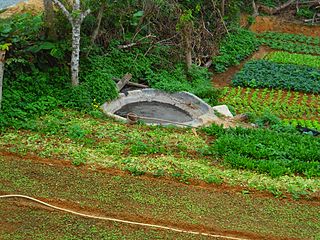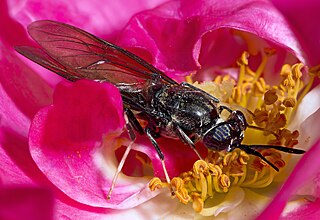
Compost is a mixture of ingredients used as plant fertilizer and to improve soil's physical, chemical, and biological properties. It is commonly prepared by decomposing plant and food waste, recycling organic materials, and manure. The resulting mixture is rich in plant nutrients and beneficial organisms, such as bacteria, protozoa, nematodes, and fungi. Compost improves soil fertility in gardens, landscaping, horticulture, urban agriculture, and organic farming, reducing dependency on commercial chemical fertilizers. The benefits of compost include providing nutrients to crops as fertilizer, acting as a soil conditioner, increasing the humus or humic acid contents of the soil, and introducing beneficial microbes that help to suppress pathogens in the soil and reduce soil-borne diseases.

Hydroponics is a type of horticulture and a subset of hydroculture which involves growing plants, usually crops or medicinal plants, without soil, by using water-based mineral nutrient solutions in aqueous solvents. Terrestrial or aquatic plants may grow with their roots exposed to the nutritious liquid or in addition, the roots may be mechanically supported by an inert medium such as perlite, gravel, or other substrates.
The following outline is provided as an overview of and topical guide to agriculture:

A land lab is an area of land that has been set aside for use in biological studies. Thus, it is literally an outdoor laboratory based on an area of land.

Vermicompost (vermi-compost) is the product of the decomposition process using various species of worms, usually red wigglers, white worms, and other earthworms, to create a mixture of decomposing vegetable or food waste, bedding materials, and vermicast. This process is called vermicomposting, while the rearing of worms for this purpose is called vermiculture.

Aquaponics is a food production system that couples aquaculture with hydroponics whereby the nutrient-rich aquaculture water is fed to hydroponically grown plants.

Aeroponics is the process of growing plants in the air or mist environment without soil or an aggregate medium. The word "aeroponic" is derived from the Greek meanings of aer ("air") and ponos ("labour"). It is a subset of hydroponics, since water is used in aeroponics to transmit nutrients.

Organic fertilizers are fertilizers that are naturally produced. Fertilizers are materials that can be added to soil or plants, in order to provide nutrients and sustain growth. Typical organic fertilizers include all animal waste including meat processing waste, manure, slurry, and guano; plus plant based fertilizers such as compost; and biosolids. Inorganic "organic fertilizers" include minerals and ash. The organic-mess refers to the Principles of Organic Agriculture, which determines whether a fertilizer can be used for commercial organic agriculture, not whether the fertilizer consists of organic compounds.

In biology, detritus is dead particulate organic material, as distinguished from dissolved organic material. Detritus typically includes the bodies or fragments of bodies of dead organisms, and fecal material. Detritus typically hosts communities of microorganisms that colonize and decompose it. In terrestrial ecosystems it is present as leaf litter and other organic matter that is intermixed with soil, which is denominated "soil organic matter". The detritus of aquatic ecosystems is organic material that is suspended in the water and accumulates in depositions on the floor of the body of water; when this floor is a seabed, such a deposition is denominated "marine snow".

Vertical farming is the practice of growing crops in vertically stacked layers. It often incorporates controlled-environment agriculture, which aims to optimize plant growth, and soilless farming techniques such as hydroponics, aquaponics, and aeroponics. Some common choices of structures to house vertical farming systems include buildings, shipping containers, tunnels, and abandoned mine shafts. As of 2020, there is the equivalent of about 30 ha of operational vertical farmland in the world.

Hermetia illucens, the black soldier fly, is a common and widespread fly of the family Stratiomyidae. Since the late 20th century H. illucens has increasingly been gaining attention because of its usefulness for recycling organic waste and generating animal feed.

Deep water culture (DWC) is a hydroponic method of plant production by means of suspending the plant roots in a solution of nutrient-rich, oxygenated water. Also known as deep flow technique (DFT), floating raft technology (FRT), or raceway, this method uses a rectangular tank less than one foot deep filled with a nutrient-rich solution with plants floating in Styrofoam boards on top. This method of floating the boards on the nutrient solution creates a near friction-less conveyor belt of floating rafts. DWC, along with nutrient film technique (NFT), and aggregate culture, is considered to be one of the most common hydroponic systems used today. Typically, DWC is used to grow short-term, non-fruiting crops such as leafy greens and herbs. The large volume of water helps mitigate rapid changes in temperature, pH, electrical conductivity (EC), and nutrient solution composition.

Lightweight expanded clay aggregate (LECA) or expanded clay (exclay) is a lightweight aggregate made by heating clay to around 1,200 °C (2,190 °F) in a rotary kiln. The yielding gases expand the clay by thousands of small bubbles forming during heating producing a honeycomb structure. LECA has an approximately round or potato shape due to circular movement in the kiln and is available in different sizes and densities. LECA is used to make lightweight concrete products and other uses.
Microponics is the symbiotic integration of fish, plants, and micro-livestock in a semi-controlled environment. The term was adopted by Australian urban farmer, Gary Donaldson, in 2008, to describe his integrated backyard food production concept. While microponics was also the name given to an obscure grafting method used in hydroponics, Donaldson's use of the term was derived from the integration of micro-livestock and the production of fish and plants - aquaponics.
Organic hydroponics is a hydroponics culture system based on organic agriculture concepts that does not use synthetic inputs such as fertilizers or pesticides. In organic hydroponics, nutrient solutions are derived from plant and animal material or naturally mined substances. Most studies on the topic have focused on the use of organic fertilizer.

Reuse of human excreta is the safe, beneficial use of treated human excreta after applying suitable treatment steps and risk management approaches that are customized for the intended reuse application. Beneficial uses of the treated excreta may focus on using the plant-available nutrients that are contained in the treated excreta. They may also make use of the organic matter and energy contained in the excreta. To a lesser extent, reuse of the excreta's water content might also take place, although this is better known as water reclamation from municipal wastewater. The intended reuse applications for the nutrient content may include: soil conditioner or fertilizer in agriculture or horticultural activities. Other reuse applications, which focus more on the organic matter content of the excreta, include use as a fuel source or as an energy source in the form of biogas.

The Sustainable Technology Optimization Research Center (STORC) is a research facility located on the California State University Sacramento campus. There are several players included in operations at the STORC including Sacramento State's Risk Management, the College of Engineering and Computer Science (ECS), and two professors in the Environmental Studies department Brook Murphy and Dudley Burton. The STORC facility is primarily maintained by California State University, Sacramento student interns and volunteers who use applied science and technology to address real world policy, food, health, and energy issues of present-day society. Research at the STORC encompasses engineering and science to test and evaluate new ideas and approaches of sustainable technology to solve environmental problems. Faculty and students address sustainability with an interdisciplinary studies approach. The STORC Vision is to become "an international resource for practical, scalable, and financially viable solutions in the area of sustainable technologies that are suitable for private and/or public sector operations related to the management of energy, food, water, and waste". The STORC Mission is "to demonstrate the operation of innovative commercially viable physical systems that are underpinned by sustainable technologies, and to disseminate the associated plans, public policy discourse, and scientific findings".

Anthroponics is a type of hydroponics system that uses human waste like urine as the source of nutrients for the cultivated plants. In general, the human urine or mixed waste is collected and stored for a period of time, before being applied either directly or passed through a biofilter before reaching the plants. As a form of organic hydroponics, anthroponics combines elements of both hydroponics and aquaponics systems.
The Kratky method is a passive hydroponic technique for growing plants suspended above a reservoir of nutrient-rich water. Because it is a non-circulating technique, no additional inputs of water or nutrients are needed after the original application, and no electricity, pumps, or water and oxygen circulation systems are required. The Kratky method has applications both for commercial food production and as a small-scale and low-maintenance technique for home growers. It has been described as "the simplest hydroponic system."
Home composting is the process of using household waste to make compost at home. Composting is the biological decomposition of organic waste by recycling food and other organic materials into compost. Home composting can be practiced within households for various environmental advantages, such as increasing soil fertility, reduce landfill and methane contribution, and limit food waste.














